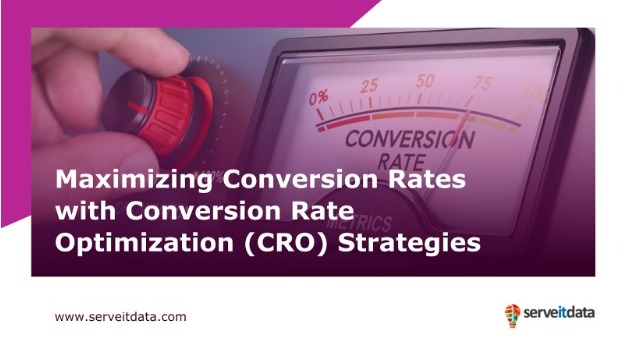Maximizing Conversion Rates with Conversion Rate Optimization (CRO) Strategies
In the world of digital marketing, driving traffic to your website is only the first step towards success. The ultimate goal is to convert that traffic into valuable leads or customers. This is where Conversion Rate Optimization (CRO) comes into play. CRO focuses on maximizing the percentage of website visitors who take a desired action, such as making a purchase, signing up for a newsletter, or filling out a contact form. In this article, we will explore effective CRO strategies that can help you maximize your conversion rates and achieve your business goals.
Conduct In-depth Data Analysis:
Before diving into CRO strategies, it is important to gather and analyze data about your website and its visitors. Utilize tools like Google Analytics to identify trends, track user behavior, and identify areas of improvement. By understanding how users navigate your site and where they drop off, you can uncover valuable insights and make data-driven decisions.
Clearly Define Conversion Goals:
To optimize your conversion rates, it is crucial to have clearly defined conversion goals. Determine what actions you want your visitors to take, whether it’s making a purchase, filling out a form, or subscribing to a service. Once you have defined your goals, you can align your CRO strategies to target those specific actions.
Optimize Website Design and User Experience:
A well-designed website with a user-friendly interface can significantly impact conversion rates. Ensure that your website is visually appealing, easy to navigate, and optimized for different devices. Use clear and compelling calls-to-action (CTAs) that guide users towards the desired conversion. Streamline the checkout process and minimize any barriers or distractions that may deter users from completing the desired action.
Implement A/B Testing:
A/B testing is a powerful CRO technique that involves comparing two versions of a webpage or element to determine which one performs better in terms of conversion rates. Test different variations of headlines, CTAs, layouts, colors, and images to identify the most effective combinations. Continuously monitor and refine your tests to achieve incremental improvements in conversion rates over time.
Create Compelling and Relevant Content:
Content plays a vital role in CRO. Craft persuasive and engaging content that highlights the value and benefits of your products or services. Use clear and concise language, address customer pain points, and provide compelling reasons for users to take action. Tailor your content to different stages of the buyer’s journey and personalize it based on user segments to enhance relevance.
Optimize Landing Pages:
Landing pages are critical for converting visitors into leads or customers. Optimize your landing pages by aligning them with specific campaigns or offers. Ensure that the messaging is consistent, the page load speed is optimized, and the form fields are minimal and easy to fill. Use social proof, customer testimonials, and trust signals to build credibility and encourage conversions.
Leverage Social Proof:
Social proof is a powerful psychological trigger that can significantly influence conversion rates. Incorporate customer reviews, testimonials, case studies, and social media mentions to demonstrate the credibility and trustworthiness of your brand. Highlight positive experiences and outcomes to instill confidence in potential customers and encourage them to convert.
Implement Exit Intent Pop-ups and Remarketing:
Exit intent pop-ups and remarketing tactics can help recover visitors who are about to leave your site without converting. Utilize exit intent technology to display targeted offers, discounts, or compelling content when users show signs of leaving. Implement remarketing campaigns to reach out to users who have previously shown interest in your products or services, keeping your brand top of mind and increasing the chances of conversion.
Monitor and Optimize Funnel Performance:
Analyze your conversion funnel to identify potential drop-off points and areas for improvement. Optimize each stage of the funnel by addressing any friction points, reducing form abandonment, and ensuring a seamless user experience throughout the entire journey. Use remarketing, personalized email campaigns, and targeted offers to re-engage users who have shown interest but did not convert.
Continuously Test, Measure, and Refine:
CRO is an ongoing process that requires continuous testing, measurement, and refinement. Monitor key performance indicators (KPIs) such as conversion rates, bounce rates, and engagement metrics to gauge the effectiveness of your strategies. Use the insights gained from data analysis, user feedback, and A/B testing to make informed decisions and continuously optimize your conversion rates.
In conclusion, maximizing conversion rates through effective CRO strategies is essential for achieving success in digital marketing. By conducting in-depth data analysis, optimizing website design and user experience, implementing A/B testing, creating compelling content, leveraging social proof, and continuously monitoring and refining your strategies, you can increase your conversion rates and drive better results for your business. Remember, CRO is an iterative process, and it requires ongoing optimization and adaptation to meet the ever-changing needs and expectations of your target audience.


